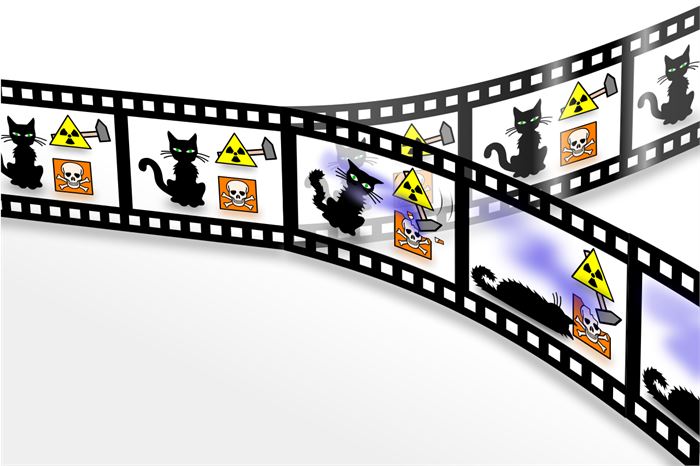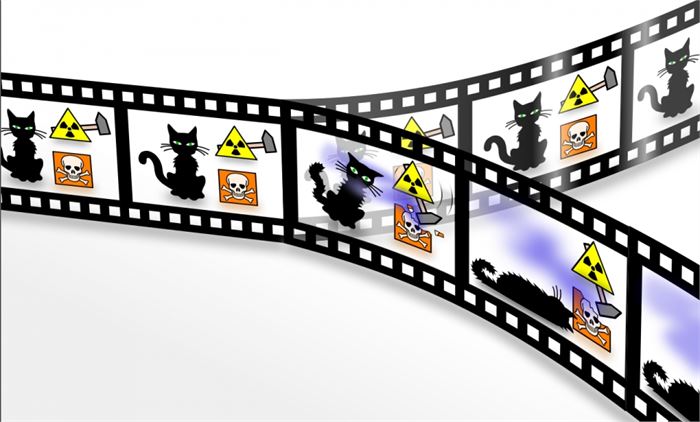 다세계 해석을 제창한 휴 에버렛(왼쪽)과 에버렛의 이론과 삶을 조명한 BBC 다큐멘터리 'Parallel Worlds, Parallel Lives'(2007)에 출연한 그의 아들 마크 에버렛. 마크는 미국의 컬트 밴드 Eels의 리더 싱어이다.
다세계 해석을 제창한 휴 에버렛(왼쪽)과 에버렛의 이론과 삶을 조명한 BBC 다큐멘터리 'Parallel Worlds, Parallel Lives'(2007)에 출연한 그의 아들 마크 에버렛. 마크는 미국의 컬트 밴드 Eels의 리더 싱어이다.
다세계 해석은 측정에 반드시 수반되는 ‘파동함수 붕괴’ 문제를 말끔히 해소함으로써 코펜하겐 해석의 대안으로 주목받는 양자역학의 해석 중 하나이다.
다세계 해석(MWI)은 미국 프린스턴 대학의 대학원생이었던 에버렛이 박사학위 논문으로 쓴 ‘양자역학의 상대 상태의 공식화(Relative State Formulation of Quantum Mechanics)’(1957)가 원점이다.
에버렛이 처음 시작할 때 논문 제목은 ‘유니버설 파동함수 이론’(The Theory of the Universal Wave Function)이었는데, 그의 지도교수인 휠러(John Wheeler)가 앞의 제목으로 바꾸기를 권유했다. 당초 에버렛은 자신의 접근 방식을 ‘상관관계 해석 Correlation Interpretation’이라고 불렀다. 여기서 상관관계 correlation는 양자 얽힘quantum entanglement을 나타낸다.
에버렛에 따르면 ‘유니버셜 파동함수’는 ‘기본적인 물리적 실체’ 또는 ‘항상 결정론적 파동방정식을 따르는 기본 실체’로 간주되는 존재 전체의 파동함수 또는 양자 상태이다.
다세계 해석의 핵심 개념이 ‘유니버셜 파동함수’에서 도출된 것은 당연하다. 다세계 해석은 ‘유니버셜 파동함수(universal wave function)’가 객관적으로 실재하고 파동함수의 붕괴가 없다고 주장한다. 이 해석에 따르면, 양자 측정의 모든 가능한 결과가 어떤 ‘세계’ 또는 ‘우주’에서 물리적으로 실현된다.
‘슈뢰딩거의 고양이’ 사고 실험도 에버렛의 다세계 아이디어에 영감을 주었다. 슈뢰딩거는 양자 상태가 중첩의 원리에 의해 다중으로 존재할 수 있다는 가설로부터 거시세계의 고양이 역시 현실에서 다중으로 존재해야 한다고 논증한다.
이는 코펜하겐 해석의 모순점을 지적하는 한편, 이를 관측하는 사람 (관측자) 역시 다중으로 존재한다는 새로운 시각의 탄생을 가능케 했다. ‘슈뢰딩거 고양이’는 나아가 관측자가 다중으로 존재한다는 것은 관측자가 존재하는 세계가 다중으로 존재한다는 것이며, 결국 다세계가 존재한다는 결론을 이끌어낸다.
에버렛은 이 점에 착안해 일어날 가능성이 있는 사건은 분리된 세계에서는 모두 ‘실현’된다고 했다.
다세계 해석은 에버렛(Hugh Everett)의 이름을 따서 에버렛 해석(the Everett interpretation) 혹은 그의 논문의 핵심 개념을 딴 ‘상대 상태 공식화( the relative state formulation)’로 불렸다. 1970년대에 미국의 이론물리학자 브라이스 디윗(Bryce DeWitt)이 이를 ‘다세계 해석’이라고 명명해 유명해졌다.
Everett의 다세계 제안은 선례가 없는 것이 아니다.
1952년 어윈 슈뢰딩거(Erwin Schrödinger)는 더블린에서 강의를 하면서 “미친 소리처럼 들릴지도 모르겠다”면서 다음과 같이 말했다.
“슈뢰딩거 방정식이 여러 다른 역사를 설명하는 것처럼 보이는데 이들 중 하나가 아니라 모든 것이 실제로 동시에 발생한다.”
David Deutsch에 따르면 이것은 다세계에 대한 알려진 최초의 언급이다. 과학철학자 Jeffrey A. Barrett은 Everett과 Schrödinger 사이의 "일반적인 관점"의 유사성을 나타내는 것으로 설명한다.
다세계 해석은 ‘파동함수 붕괴’ 문제를 어떻게 해석할까?
다세계 해석은 파동함수 붕괴를 양자 결어긋남과 양자 얽힘의 메커니즘으로 설명한다. 결어긋남은 간섭 현상을 일으킬 수 있는 결맞음(coherence) 상태가 관측 같은 외부와의 상호작용에 의해 깨지고 양자적 특성을 잃는 과정을 말한다.
다세계 해석에 따르면, ‘파동함수 붕괴’가 일어나는 것이 아니라 사건의 가능한 모든 결과들이 양자 결어긋남을 통해 각자의 ‘역사’ 혹은 ‘세계’로 진행한다.
에버렛의 원래 아이디어을 적용해 ‘슈뢰딩거 고양이’를 해석해보자.
에버렛의 상대 상태(상관관계) 개념에 의하면 일반적인 상호작용 후 얽힌 시스템이 형성되고, 이 시스템은 2개 이상의 하위 시스템(상대 상태)으로 표현된다. 여기서 시스템은 관측 대상과 관측 장치 및 관측자를 포함한다.
코펜하겐 해석에서는 상자 안의 ‘안 깨진 독약병–산 고양이’ 상태와 ‘깨진 독약병-죽은 고양이’ 상태가 중첩돼 있다가 관측자에 의해 둘 중 하나는 ‘파동함수 붕괴’로 사라지고 다른 하나만 살아남아 관측자의 세계에서 진행한다. 이에 비해 다세계 해석에 따르면 상자 안의 ‘안 깨진 독약병-산 고양이’ 상태와 ‘깨진 독약병-죽은 고양이’ 상태가 애초에 따로 존재한다. 상자 밖에는 산 고양이 상태를 관측하는 관측자와 죽은 고양이를 관측하는 관측자의 세계가 따로 존재한다.
관측이라는 상호작용에 의해 관측자와 상자 안의 상태는 얽힌 시스템을 형성한다. 하나의 상대 상태 시스템은 ‘안 깨진 독약병-산 고양이-산 고양이를 보는 관찰자’이고 다른 상대 상태 시스템은 ‘깨진 독약병-죽은 고양이-죽은 고양이를 보는 관찰자’로 구성된 시스템이다. 이들 상대 상태는 관찰로 인해 결어긋남이 발생해 서로 간섭할 수 없게(소통할 수 없게) 되고 각자의 세계로 진행한다.
다세계 해석의 핵심은 다음과 같다.
일어나는 모든 사건은 서로 상관할 수 없는 다른 세계로 나뉘고, 관찰자 역시 각 세트의 세계에서 관찰한다. 세계가 관찰에 의해 갈라지는 것이 아니라 세계는 처음부터 갈라져 있었다. 모든 가능성이 함께 존재한다. 이 세계에 현재 존재하는 관찰 대상이나 관찰자 역시 가능성의 일부이다.
 다세계 해석에 따른 양자 역학 "슈뢰딩거의 고양이" 역설. 이 해석에서 모든 양자 이벤트는 분기점이다. 고양이는 상자가 열리기 전에도 살아 있고 죽은 상태이지만 "살아있는" 고양이와 "죽은" 고양이는 다중 우주의 다른 가지에 있으며 둘 다 똑같이 현실적이지만 서로 상호작용하지 않는다
다세계 해석에 따른 양자 역학 "슈뢰딩거의 고양이" 역설. 이 해석에서 모든 양자 이벤트는 분기점이다. 고양이는 상자가 열리기 전에도 살아 있고 죽은 상태이지만 "살아있는" 고양이와 "죽은" 고양이는 다중 우주의 다른 가지에 있으며 둘 다 똑같이 현실적이지만 서로 상호작용하지 않는다
다세계 해석은 반생반사 상태의 고양이나 파동의 붕괴라는 요상한 개념도 필요 없고, 논리적인 모순도 없이 ‘슈뢰딩거 고양이’를 설명할 수 있다. 단, ‘고양이가 살아 있는 세계와 죽어 있는 세계가 정말로 평행하게 존재하는가.’라는 질문을 확인해주지 못한다.
다세계 해석은 발표 당시에는 외면 받았지만 에버렛의 사망(1982년) 후 많은 물리학자와 우주론학자들의 영감의 원천이 되었다. 요즘 물리학계에서도 진지하게 논의되고 있는 다중우주론은 에버렛의 다세계 해석에 힘입은 바 크다.
양자 얽힘과 결어긋남의 원리는 다세계 해석의 다중 우주의 개념을 설명한다. 관측자와 관측 장비, 그리고 그 외의 모든 것들은 관측을 기점으로 둘로 분리된다. 관측이 실행되기 전에는 하나였던 것들이 관측과 동시에 '두 개의 관측 장비'와 '두 사람의 관측자', 그리고 두 세트의 '그 외의 모든 것들'로 분리된다. 이는 두 개의 실체가 공존한다는 뜻이자 두 개의 우주가 공존한다는 의미이다. 그러나 각각의 세계 존재하는 관측자에게는 오직 하나의 결과만이 나타날 뿐이어서 그의 인식은 보존된다.
MIT 물리학과 교수인 맥스 테그마크(Max Tegmark)는 최근 발간한 ‘맥스 테그마크의 우주’를 통해 “빅뱅의 난점을 해결해주는 인플레이션이론에서 평행우주가 수학적으로 도출된다”며 “많은 물리학자들이 이를 진지하게 받아들이기 시작했다”고 소개했다.
그러나 다세계 해석은 비록 코펜하겐 해석의 난점을 이론적으로 설명해주긴 하지만, ‘평행우주’의 존재를 확인할 수 없는 데다 상식과 너무나 괴리가 큰 ‘무수한 우주’, ‘무수한 나’를 필연적으로 만들어낸다는 한계를 지닌다. 이 과정은 물리량 보존의 법칙에 위반된다.
다세계 해석은 논리적인 모순은 없지만 일반적인 과학이론의 요건(필수요건은 아니지만) 가운데 자주 인용되는 두 가지를 만족시키지 못한다. 그 하나는 반증할 수 없다는 것이다.
과학철학자 칼 포퍼는 반증 가능하지 않은 이론은 과학이 아니라고 주장했는데, 다세계 해석이 이에 해당한다. 물리적으로 우리 우주 안에서 다른 우주와 소통할 수 없다. 따라서 다세계 해석에서 말하는 지금 내가 속한 우주 외의 다른 우주의 '나'를 확인할 방법이 없다. 수많은 우주가 존재하고 또 그 우주마다 나 아닌 또 다른 내가 존재한다는 사실을 어떻게 증명할 수 있을까?
두 번째는 ‘불필요한 것을 덧붙이지 말라’는 ‘오컴의 면도날’ 원리를 거스른다는 것이다. 오컴은 “조금이면 족할 것을 가지고 많이 사용하는 것은 낭비다”고 했다. ‘무한개 파동의 붕괴’라는 가정이 불합리하다면서 ‘무한개의 우주’를 지어낸다는 것은 터무니없이 불필요한 낭비가 아닐까?
Many-worlds interpretation
 Hugh Everett (left), who invented the many-worlds interpretation, and his son Mark Everett, who was the lead singer of cult US band the Eels, appeared in the BBC documentary 'Parallel Worlds, Parallel Lives' (2007), which shed light on Everett's theory and life.
Hugh Everett (left), who invented the many-worlds interpretation, and his son Mark Everett, who was the lead singer of cult US band the Eels, appeared in the BBC documentary 'Parallel Worlds, Parallel Lives' (2007), which shed light on Everett's theory and life.
The many-world interpretation is one of the interpretations of quantum mechanics that is attracting attention as an alternative to the Copenhagen interpretation by completely solving the problem of ‘wave function collapse’ that is necessarily accompanied by measurement.
The Many-Worlds Interpretation(MWI) has its origin in Everett, who was a graduate student at Princeton University in the United States, in his doctoral dissertation ‘The Relative State Formulation of Quantum Mechanics’(1957).
When Everett first started, the title of his dissertation was “The Theory of the Universal Wave Function,” but his supervisor John Wheeler recommended that he change it to the previous title. Initially, Everett called his approach “Correlation Interpretation”. Here, correlation refers to quantum entanglement.
According to Everett, the ‘universal wave function’ is the wave function or quantum state of the whole of being considered as ‘a fundamental physical entity’ or ‘a fundamental entity that always obeys the deterministic wave equation’.
It goes without saying that the core concept of many-worlds interpretation was derived from the ‘universal wave function’. The many-worlds interpretation asserts that the ‘universal wave function’ is objectively real and that there is no collapse of the wave function. According to this interpretation, all possible outcomes of quantum measurements are physically realized in some 'world' or 'universe'.
The 'Schrödinger's cat' thought experiment also inspired Everett's many-worlds idea. Schrödinger argues that from the hypothesis that quantum states can exist in multiples by the principle of superposition, cats in the macroscopic world must also exist in multiples in reality.
While pointing out the contradiction of the Copenhagen interpretation, it enabled the birth of a new perspective that observers also exist in multiples. ‘Schrödinger’s Cat’ goes further and leads to the conclusion that multiple observers exist, meaning that there are multiple worlds in which observers exist, and eventually multiple worlds exist.
Everett took note of this point and said that all possible events would “realize” in the separated world.
The many-worlds interpretation has been called the Everett interpretation, after Hugh Everett, or the relative state formulation, after a key concept in his dissertation. In the 1970s, American theoretical physicist Bryce DeWitt named it the “many-worlds interpretation” and became famous.
Everett's many-worlds proposal is not without precedent.
In 1952, while giving a lecture in Dublin, Erwin Schrödinger said, “It may sound lunatic.”
“The Schrödinger equation seemed to be describing several different histories, they were ‘not alternatives but all really happen simultaneously’”
According to David Deutsch, this is the first known reference to many-worlds.
Philosopher of science Jeffrey A. Barrett describes it as indicating the similarity of "general views" between Everett and Schrödinger.
How does the many-worlds interpretation interpret the problem of ‘wave function collapse’?
The many-worlds interpretation explains the wave function collapse as a mechanism of quantum decoherence and quantum entanglement. decoherence refers to a process in which a state of coherence, which can cause interference, is broken by interaction with the outside, such as observation, and loses quantum properties.
According to the many-worlds interpretation, ‘wave function collapse’ does not occur, but all possible outcomes of events proceed to their respective ‘history’ or ‘world’ through quantum decoherence.
Let's interpret "Schrödinger's Cat" by applying Everett's original idea.
According to Everett's concept of relative state (correlation), an entangled system is formed after general interaction, and this system is represented by two or more subsystems (relative state). Here, the system includes an observation object, an observation device, and an observer.
In the Copenhagen interpretation, the 'unbroken poison bottle - alive cat' state and the 'broken poison bottle - dead cat' state in the box are superposed. And one of them disappears due to 'wave function collapse' by the observer, and the other survives in the observer's world. On the other hand, according to the many-worlds interpretation, the states of ‘unbroken poison bottle-alive cat’ and ‘broken poison bottle-dead cat’ in the box originally exist separately. Outside the box, there exists a world of observers observing the state of alive cats and observers observing dead cats.
Through the interaction of observation, the observer and the state in the box form an entangled system. One relative state system is 'unbroken poison vial - alive cat - observer looking at alive cat' and the other is 'broken poison vial - dead cat - observer seeing dead cat'. These relative states are separated due to observation, so they cannot interfere with each other (cannot communicate) and proceed to their respective worlds.
The key points of the many-worlds interpretation is as follows.
Every event that happens is divided into different worlds that cannot be correlated with each other, and the observer also observes in each set of worlds. It is not that the world is divided by observation; the world has been divided from the beginning. All possibilities exist together. Observation objects and observers currently existing in this world are also part of the possibility.
 The quantum-mechanical "Schrödinger's cat" paradox according to the many-worlds interpretation. In this interpretation, every quantum event is a branch point; the cat is both alive and dead, even before the box is opened, but the "alive" and "dead" cats are in different branches of the multiverse, both of which are equally real, but which do not interact with each other.
The quantum-mechanical "Schrödinger's cat" paradox according to the many-worlds interpretation. In this interpretation, every quantum event is a branch point; the cat is both alive and dead, even before the box is opened, but the "alive" and "dead" cats are in different branches of the multiverse, both of which are equally real, but which do not interact with each other.
The many-worlds interpretation does not require a cat in a half alive-half dead state or the strange concept of wave function collapse, and can explain the 'Schrödinger cat' without logical contradiction. However, it does not confirm the question, ‘Does the world where cat is alive and the world where cat is dead really exist in parallel?’
The many-worlds interpretation was ignored at the time of publication, but after Everett's death(1982), it became a source of inspiration for many physicists and cosmologists. The multiverse theory, which is being seriously discussed in the physics world these days, owes much to Everett's many-worlds interpretation.
The principle of quantum entanglement and decoherence explains the multiverse concept of the many-worlds interpretation. The observer, the observation equipment, and everything else are separated in two by the time of observation. What was one prior to the observation is separated into 'two observation equipments' and 'two observers' and two sets of 'everything else' at the same time as the observation. This means that two entities coexist, and it means that two universes coexist. But for each world-existing observer, only one result emerges, so his perception is preserved.
Max Tegmark, professor of physics at MIT, said in his recently published 'Our Mathematical Universe', "The parallel universe is mathematically derived from the inflation theory that solves the difficulty of the Big Bang. many physicists are beginning to accept it.”
However, although the many-worlds interpretation theoretically explains the difficulty of the Copenhagen interpretation, it cannot confirm the existence of a 'parallel universe' and inevitably creates 'innumerable universes' and 'countless me' that are too far apart from common sense. This process violates the law of conservation of physical quantities.
The many-worlds interpretation, while not logically contradictory, does not satisfy two of the frequently cited (but not required) requirements of a general scientific theory. One is that it cannot be disproved.
Philosopher of science Karl Popper argued that a theory that cannot be falsified is not science, and the many-worlds interpretation falls under this category.
Physically, we cannot communicate with other universes within our universe. Therefore, in the multi-world interpretation, there is no way to confirm the 'me' of another universe other than the one ‘me’ belong to now. How can I prove that there are many universes and that there is another me other than me in each universe?
The second is that it violates the principle of 'Occam's Razor', which states that 'Plurality is not to be posited without necessity'. Occam said, “It is a waste to use much of what is sufficient for a little.” Wouldn't it be absurdly unnecessary waste to invent an 'infinite universe' if the hypothesis of 'collapse of infinite waves' is unreasonable?
<pinepines@injurytime.kr>